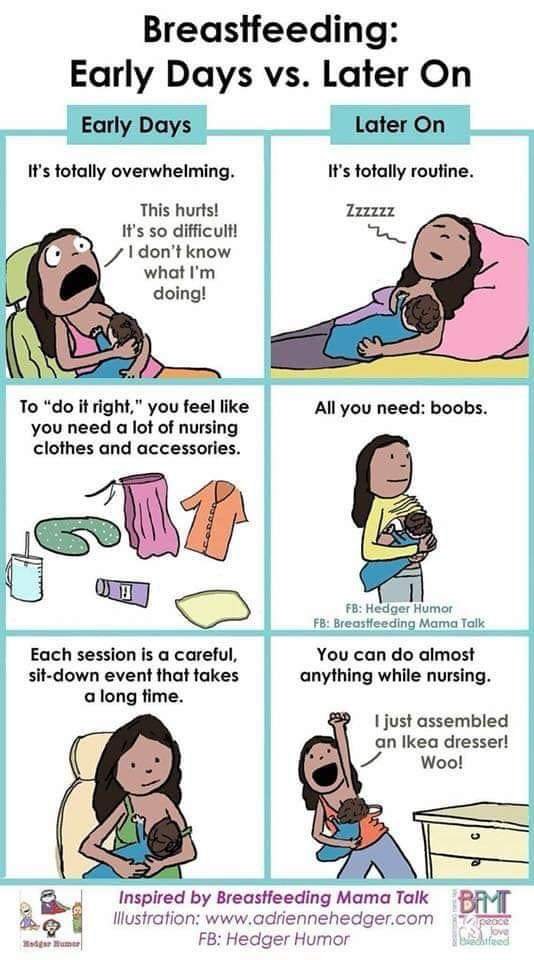Breastfeeding often gets easier after the first few weeks. Many mothers find a routine by week six.
It can feel overwhelming at first. New moms face challenges like latching issues, sore nipples, and sleepless nights. But remember, you are not alone. These early days are a learning phase for you and your baby. Each day brings more comfort and ease.
Support from family, friends, and healthcare professionals can make a big difference. Patience and perseverance are key. As you and your baby grow together, breastfeeding becomes more natural. Keep in mind, every mother’s journey is unique. Trust your instincts, seek help when needed, and celebrate small victories. Soon, breastfeeding will feel less like a challenge and more like a bonding experience.
Early Challenges
Breastfeeding often becomes easier after the initial weeks. New mothers face challenges like latching difficulties and sore nipples. With time, practice helps overcome these hurdles, leading to a smoother experience.
Breastfeeding is a journey filled with both joy and challenges. In the early days, many new mothers find themselves navigating unfamiliar waters. It’s not uncommon to feel overwhelmed and question if it will ever get easier. Understanding the initial hurdles can help you better prepare and persevere through the tough times.Common Initial Hurdles
During the first few weeks, many mothers face physical challenges like sore nipples and latch issues. You might find your baby struggling to latch on properly, which can be frustrating and painful. Are you experiencing frequent feedings that leave you exhausted? This is a common struggle, as newborns often feed every two to three hours.Supply concerns can also add to your stress. You might worry if your baby is getting enough milk, especially when they seem hungry shortly after feeding. Engorgement can be another hurdle, making you feel uncomfortable and anxious.Emotional Struggles
The emotional toll of breastfeeding can be significant. Exhaustion from sleepless nights can make it hard to stay positive. Have you ever felt isolated or unsure of your abilities as a mother?Anxiety about returning to work or maintaining your milk supply can weigh heavily on your mind. You might also feel societal pressure to breastfeed, adding to your stress and emotional burden.Remember, you’re not alone. Many mothers have faced these challenges and found ways to overcome them. Could sharing your experiences with a support group or trusted friend help lighten your load? Sometimes, just knowing others understand can make a world of difference.
Credit: www.mamanatural.com
Physical Adjustments
Breastfeeding becomes easier around six to eight weeks as both mother and baby adjust physically. During this period, latch issues often improve, and milk supply stabilizes, making feeding more comfortable. Understanding this timeline helps new mothers feel more confident and patient in their breastfeeding journey.
Breastfeeding is a journey that involves various physical adjustments. These changes can be challenging, but understanding them can make the experience smoother. Your body undergoes significant transformations, and with time, these changes can become more manageable, making breastfeeding easier. Let’s explore some specific adjustments and how you can navigate them.Body Changes
Your body is remarkable, and during breastfeeding, it continues to evolve. Your breasts may feel fuller and heavier as they produce milk. This can be uncomfortable initially, but your body will gradually adapt.You might notice changes in your nipples. They can become more sensitive or even sore. This is common, especially in the early days of breastfeeding. Using nipple creams or shields can help soothe discomfort.Consider tracking these changes. Keeping a journal can help you notice patterns. Recognizing these patterns can empower you to manage your breastfeeding journey better.Pain Management
Experiencing pain during breastfeeding is not unusual. Many new mothers find it difficult to cope with the discomfort. But remember, you are not alone, and there are ways to alleviate the pain.Firstly, ensure your baby is latching correctly. A poor latch can cause significant pain. Adjusting your baby’s position can make a difference. Consult a lactation expert if needed.Try warm compresses on your breasts. This can relieve soreness and promote milk flow. Massaging your breasts gently can also help in reducing pain.Explore different nursing positions. Sometimes, a simple change in posture can ease discomfort. Finding what works best for you is crucial.Have you found any specific strategies that helped you manage breastfeeding pain? Sharing your experiences might inspire others on their journey.Breastfeeding requires patience and persistence. The physical adjustments are part of the process, and with the right approach, you can make it a more comfortable experience.Building Routine
Building a routine in breastfeeding can ease the process for new mothers. Establishing a predictable rhythm helps both mother and baby feel more comfortable. Understanding the benefits of a routine can lead to a more enjoyable experience.
Setting A Schedule
Creating a consistent feeding schedule aids in establishing a routine. Babies thrive on predictability, and knowing when to expect feeding time brings comfort. Start by observing your baby’s natural feeding pattern. Gradually adjust to a more structured timetable that suits both of you.
Consistency helps regulate your milk supply. Feeding at regular intervals encourages your body to produce milk efficiently. This can lead to less stress and a smoother breastfeeding journey.
Creating A Comfortable Environment
A cozy environment enhances the breastfeeding experience. Find a quiet space free from distractions. Use a comfortable chair or pillow to support your back and arms. Comfort promotes relaxation for both mother and baby.
Adjust lighting to be soft and soothing. Keep essentials like water and snacks nearby. This preparation helps maintain focus on bonding with your baby. A peaceful setting encourages longer feeding times and a stronger connection.
Finding Support
Breastfeeding often becomes easier around the six-week mark. Many mothers find relief as baby learns to latch better. Support from lactation consultants or support groups can make this transition smoother.
Breastfeeding is a beautiful journey, but it can also be challenging. Finding support can make all the difference in overcoming hurdles and making the experience more enjoyable. Many new mothers wonder when breastfeeding will get easier. A strong support system can provide the encouragement and resources you need to persevere through the tough times.Professional Guidance
Seeking help from a lactation consultant can be invaluable. These experts provide personalized advice and practical techniques tailored to your needs.A friend of mine struggled with latching issues. A lactation consultant taught her effective positioning techniques that transformed her breastfeeding experience.Healthcare providers like pediatricians can also offer guidance. They can address concerns about your baby’s weight gain or feeding habits.Don’t hesitate to reach out and ask questions. Professional support can alleviate many breastfeeding worries.Community Resources
Local breastfeeding support groups can be a game-changer. Connecting with other mothers who share similar experiences can provide emotional comfort and practical tips.Online forums and social media groups offer a space to ask questions and share stories. You might find a community of mothers who have faced the same challenges and found creative solutions.Consider attending workshops or classes at hospitals or community centers. These resources often provide hands-on learning and foster a sense of belonging.Have you ever considered how a simple conversation with another mom could change your perspective? You might find a newfound confidence and motivation to continue your breastfeeding journey.Support is all around you, and finding the right resources can make the path smoother and more enjoyable.Recognizing Improvement
Breastfeeding becomes easier as both mom and baby learn together. Moms often notice improvement after a few weeks. Confidence grows with practice, making feeding sessions smoother and more comfortable.
Recognizing improvement in breastfeeding can be a comforting milestone for new parents. The early days of breastfeeding can be challenging, with sleepless nights and a steep learning curve. Yet, as time progresses, you’ll start to notice signs that things are becoming easier. Recognizing these improvements can boost your confidence and provide reassurance that you’re on the right track.Signs Of Progress
You might start noticing that your baby latches on more easily. This could mean fewer struggles and a more comfortable experience for both of you.Your baby may also feed more efficiently, finishing nursing sessions more quickly. This change can free up more time for you to rest or engage in other activities.Another sign is the reduction of soreness or discomfort during breastfeeding. As your body adjusts, you should experience less pain, signaling progress.Increased Confidence
As you recognize these signs, you will naturally feel more confident. Trusting your instincts becomes easier when you see tangible improvements.Your ability to manage breastfeeding in different situations will grow. Whether you’re at home, visiting family, or even in public, you’ll feel more at ease.Consider how your confidence impacts your overall parenting experience. Are you more relaxed and enjoying moments with your baby? This shift is a clear sign that breastfeeding is getting easier.Engage with other parents. Share your experiences and learn from theirs. This exchange can further boost your confidence and provide additional support.Reflect on these changes and celebrate your progress. How do these signs of improvement make you feel? Embrace them as milestones in your breastfeeding journey..jpg)
Credit: www.letstalkbirthandbaby.co.uk
Tools And Techniques
Breastfeeding often becomes easier after the first few weeks. Techniques like finding comfortable positions help mothers relax. Tools such as nursing pillows and breast pumps offer support, making feeding sessions smoother and more manageable.
Breastfeeding can be a challenging journey, especially in the early days. However, with the right tools and techniques, it can become more manageable and even enjoyable. You might be wondering, what can make this experience smoother? The answer lies in using breastfeeding aids and mastering effective feeding positions. These strategies can transform your breastfeeding routine into a more comfortable and fulfilling experience. Let’s dive into how these tools can help you.Using Breastfeeding Aids
Breastfeeding aids can be lifesavers for many new moms. Breast pumps, for instance, help when you’re away from your baby or need to relieve engorged breasts. They allow you to store milk for those moments when direct feeding isn’t possible.Nipple shields can protect sore nipples and assist babies who struggle with latch. They are especially useful in the early weeks. Make sure to consult with a lactation expert to find the right size and type.There are also nursing pillows designed to support your baby and reduce strain on your arms and back. These pillows can help you maintain a comfortable position and make feeding sessions more relaxing.Effective Feeding Positions
Finding the right feeding position can significantly impact your comfort and your baby’s ability to latch. Have you tried the cradle hold? It’s a classic position that allows you to have control and support your baby easily.The football hold is ideal for moms recovering from a C-section. It keeps pressure off your abdomen while giving your baby access to your breast.Side-lying position is perfect for nighttime feeds. It lets you rest while your baby nurses. Try this position when you need to feed your baby and catch some sleep simultaneously.Experiment with different positions to find what works best for you and your baby. Each feeding session is an opportunity to learn and adjust. Are you ready to discover which combination of tools and techniques can make breastfeeding easier for you?Overcoming Obstacles
Breastfeeding challenges can seem daunting at first. Many mothers find it gets easier after the initial weeks. As both mom and baby learn the process, it becomes more natural, providing comfort and nourishment.
Breastfeeding presents challenges for many new mothers. Initial struggles often lead to questions and concerns. Knowing that you’re not alone can provide comfort. Many mothers face similar obstacles and find ways to overcome them. With patience and support, breastfeeding becomes easier.Dealing With Low Supply
A common concern is low milk supply. Mothers may worry about their baby not getting enough milk. This worry can cause stress, affecting milk production. Focus on frequent nursing sessions. The more your baby feeds, the more milk you produce. Hydration is key. Drink plenty of water throughout the day. Eating a balanced diet helps too. Foods rich in protein and vitamins support milk production. Consulting a lactation expert provides personalized advice. They offer guidance and reassurance.Handling Baby’s Fussiness
Fussiness in babies can frustrate new mothers. It often feels like something is wrong. Babies fuss for many reasons, not just hunger. They might be tired, overstimulated, or need a diaper change. Try soothing techniques like swaddling or gentle rocking. A calm environment helps reduce fussiness. Dim the lights and reduce noise to create a peaceful space. Observe your baby’s cues. Learning their signals helps address their needs promptly. With time, understanding your baby’s patterns becomes easier. “`Embracing The Journey
Breastfeeding becomes easier with time and practice. Many mothers find improvement after the initial weeks. Support and patience help in overcoming early challenges, making the experience more enjoyable.
Breastfeeding is a journey filled with highs and lows, and understanding when it gets easier can offer comfort to many new parents. Embracing this journey means acknowledging both the challenges and the triumphs along the way. It’s about recognizing that each moment, no matter how small, is a step forward.###Celebrating Milestones
Every breastfeeding milestone deserves a celebration. The first time your baby latches correctly, or when you successfully breastfeed in public, these moments are victories. They signal progress and can boost your confidence.Think about those initial days when it seemed impossible. Then, remember the first time it felt natural. That’s growth. Celebrate these achievements, no matter how minor they may seem.What milestones have you celebrated in your breastfeeding journey? Perhaps it’s the first time your baby slept through the night after a feeding. Each milestone marks a moment of ease and accomplishment.###Reflecting On Growth
Growth is not just about your baby. It’s also about you as a parent. Reflect on the skills and patience you have developed.Remember the early days filled with uncertainty? Look at how far you’ve come. Your resilience and adaptability have increased.Pause and consider how you’ve handled setbacks. Each challenge faced brings a lesson learned. What have you discovered about your strength and perseverance?In this journey, both you and your baby are growing. Embrace these changes and reflect on the progress made. How can you continue to support and nurture this growth?
Credit: www.mumilk.com.au
Frequently Asked Questions
What Is The Hardest Week Of Breastfeeding?
The first week of breastfeeding is often the hardest. New mothers and babies are adjusting and learning. Challenges like latch issues and sore nipples are common. Support and patience can help ease this transition.
At What Age Does Breastfeeding Get Easier?
Breastfeeding often gets easier around 6 to 8 weeks as both mother and baby adjust. At this stage, feeding routines become more predictable, and latching improves. Each mother’s experience can vary, so patience and support are key. Consult a lactation expert if challenges persist.
What Is The 4 4 4 Rule For Breastfeeding?
The 4 4 4 rule for breastfeeding involves feeding the baby every four hours, for four weeks, and monitoring for four signs: baby’s weight gain, wet diapers, satisfied demeanor, and proper latch. This guideline helps ensure the baby is getting enough nourishment and supports healthy growth.
Does Nursing Get Easier As A Baby Gets Older?
Nursing can become easier as the baby grows. Babies develop better feeding routines and latch skills over time. Mothers also gain more experience, making the process smoother. Each baby’s journey is unique, so experiences can vary. Consistent practice and patience often lead to a more manageable nursing experience.
When Does Breastfeeding Usually Get Easier?
Breastfeeding often gets easier around 6 to 8 weeks. Babies and moms develop a routine. Practice helps.
Conclusion
Breastfeeding becomes easier with time and practice. Patience is key. Every mother and baby is unique. Usually, around six to eight weeks, things improve. Support from family helps. Consult health professionals if needed. Trust your instincts and listen to your body.
You are doing great. Celebrate small victories. Remember, every drop counts. Enjoy the bonding with your baby. It’s a special journey. Keep going. Your confidence will grow. Relax and cherish these moments. You’re not alone in this. Many mothers feel the same.
Reach out if you need support. You got this.





